Children sat quietly around a harvest table eating with their family and talking about what farm chores needed to be done for the day. This French family was dining as if in the 1700s at New Brunswick’s Acadian Village.
A little boy, visiting with his family stood around the outside of the room watching them in fascination. It was very different from the way the little boy’s family ate their meals, and he had lots of questions.
Children learn best through their senses, especially by tasting. Here are a few of the many historic sites across Canada where families can learn what it was like to live and dine back in Canada’s past.
Site Traditionnel Huron, Quebec
Centuries before our European ancestors landed on this continent, our First Nations peoples were living well from the land, and our food history travels should begin there. In Wendake, Quebec, a replica Huron village gives visitors a look at a traditional living of the past, and no imagination is required as you walk through the longhouses. Three symbolic fires are always burning in the centre of the longhouse, providing warmth and a cooking area. Families can learn about the food that was eaten and visit a smokehouse, and curing shed to learn about life before refrigeration. At the Nek8arre Restaurant, families can enjoy a meal cooked from traditional ingredients such as wild game, fish, corn, squash and beans.
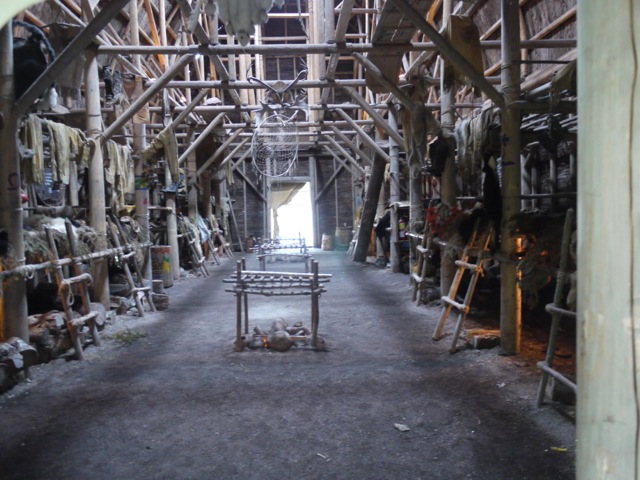
This longhouse at the Site Traditionnel in Wendake, Quebec shows the three fires always lit in the longhouses to provide warmth and fires for cooking – Photo Jan Feduck
The Wanuskewin Heritage Park, Saskatchewan
This Cultural Centre demonstrates the strong historic relationship between the Plains indigenous peoples and their lands. Roaming the lands were bison that were hunted to provide many of their needs. Each June a Han Wi-Moon Dinner is served at the Heritage Park that includes bison, foraged spices, bannock, mushrooms and a berry compote with a dandelion root crisp. It also includes storytelling and learning of the rich culture of the people of the plains. A bison herd will soon be introduced at the cultural centre.
Eskasoni Cultural Journeys in Bras d’Or Lakes Cape Breton Island. The Mi’kmaq community presents a tour through the forest that includes stops at clearings showing the hunting, fishing, music, games and bark wigwams of the early peoples of the Eskasoni area. Families can learn to make Four Cents Bread and cook it over an open fire. At the end of the walk, visitors are treated to traditional luskinigan bread and tea.
St. Marie Among the Hurons was Catholic mission in 1639 which has been reconstructed and includes a replica Huron Village. Gardens show the agriculture of the Huron peoples who planted their staples of corn, beans and squash together in a hill. In the restaurant, families can enjoy soup made of these ingredients and understand how our First Nations lived from the land so well.
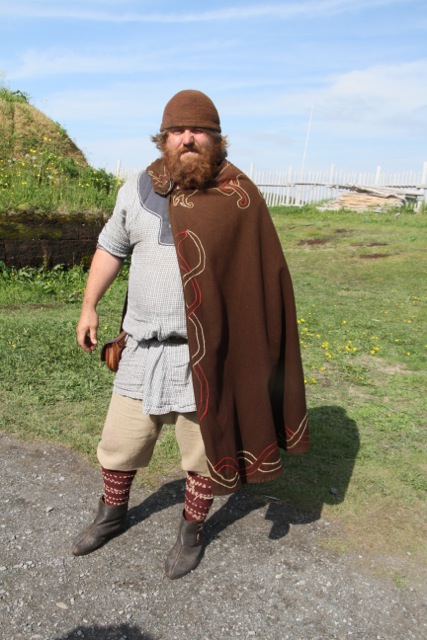
Children love asking questions to this Viking interpreter. – Photo Jan Feduck
At L’Anse Aux Meadows National Historic Site, in Newfoundland, a replica of a Viking village has been reconstructed on an archaeological site. Families can learn about how the Vikings arrived and survived life in this settlement. Over a fire in one of the longhouses, children watched as soup was cooked from vegetables grown or foraged, and the flatbread was baked. Fur clad “Vikings” bring the Village to life and children love talking to the characters to learn about their way of life and how they hunted and fished.
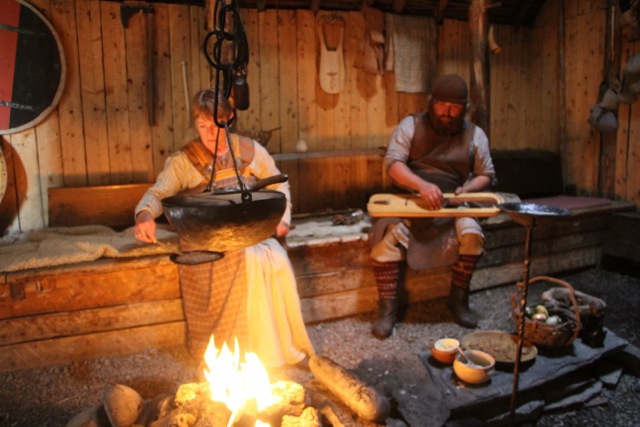
Life in the Viking longhouse at L’Anse Aux Meadows shows cooking and an instrument of the past. – Photo Jan Feduck
Fortress Louisbourg National Historic Site sits on a foggy spit of land on Cape Breton Island. This French colony was rebuilt using the original plans so as you walk through the mist, and see the buildings and people of the 1740s; it is truly a “time travel” experience. Families can watch the working kitchens of several homes as well as bread making and fish drying. Two period eateries provide a chance to eat as if in the past. Using only a pewter spoon, and eating on long tables, visitors can dine on the food of the common man. A more refined restaurant provides the fare of the wealthy.
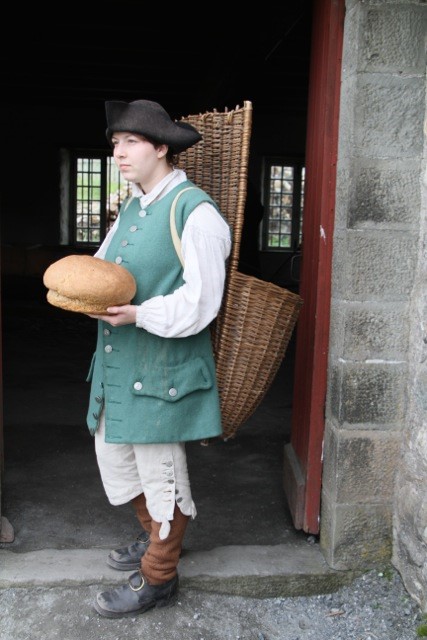
A young apprentice baker sets out to sell Soldiers Bread at Fortress Louisbourg – Photo Jan Feduck
At Louisbourg, children can participate in learning experiences for a day or weeklong camps. In period costume they help prepare food, dine and live the life of the children of Louisbourg. Older teens can join apprenticeship programs to learn to trades and the life of the teens of that time.
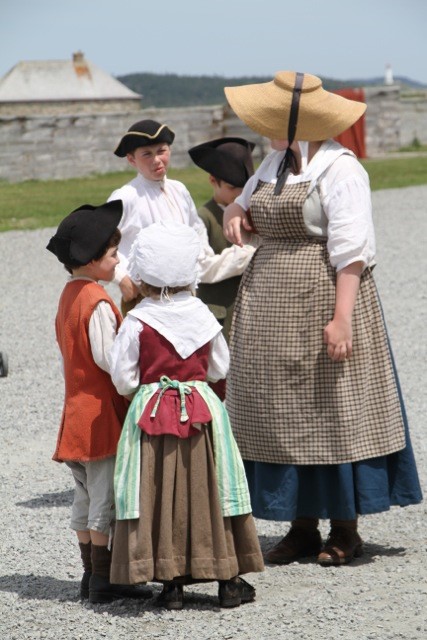
A group of children dressed as in the 1700’s in the summer program at Fortress Louisbourg – Photo Jan Feduck
Upper Canada Village in Morrisburg, Ontario is a collection of historic homes representing life in the 1860s. Families can experience all aspects of life, including farming, gardening, food preparation, bread baking, forging metal and the arts such as music and entertainment. Children love to roam the streets in period costume that can be rented. Week-long summer programs are offered to provide children with an experience of living life in the 1860s. From milking a cow to helping churn the butter and cooking, children can learn the true origins of the food we eat.
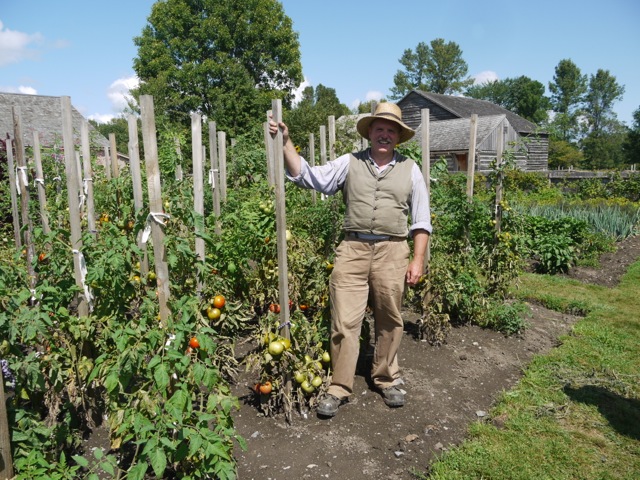
A proud gardener at Upper Canada Village demonstrates how the vegetables are grown – Photo Jan Feduck
The Acadian Village in Caraquet, New Brunswick, represents the life of Canada’s first French immigrants from 1770 to 1949. This is a little known, but essential part of Canadian history that is well told at this site. There are forty historical buildings, and each costumed interpretive staff has a story to tell or a skill to demonstrate. Cooking workshops are available, and day camps are offered for children. Families can stay overnight in an authentic Inn from the 1920s, and the restaurant on site gives a taste of traditional Acadian food.
King’s Landing in New Brunswick portrays life in a rural village in the 1800s. The staff likes to “make history jump out of the history book,” and that it does. Each visitor is encouraged to pitch in and help with the work. Visiting Cousins is a one- week camp offered for children from 9-14 years of age. They experience everything from how to milk a cow, to meal preparation and even attend school classes in a one-room schoolhouse. A program for teens enables them to specialise in their area of interest. Families can enjoy dining at the King’s Head Inn, an old stagecoach inn that once provided spartan accommodation and food for those on the road. The Inn is now a dining room that serves traditional foods such as turkey pot pie, salads, soups, loaves of bread and desserts such as Acadia Sugarpie. Staff dressed in period costume ensures that the diner is experiencing this meal as if back in the 1800s.
Heritage Park Historical Village in Calgary is Canada’s largest living history site. In one day, they say, you can “learn to churn butter, train with the NorthWest Mounted police and try dancing Blackfoot style”. This historic village covers life in Western Canada from the 1860s to the 1950s. The homes, farms, shops and even a paddlewheel riverboat bring Alberta’s history to life. Themed day camps are offered in the summer for children eight years to teens. There are numerous dining venues and many cooking activities happening in historic homes.
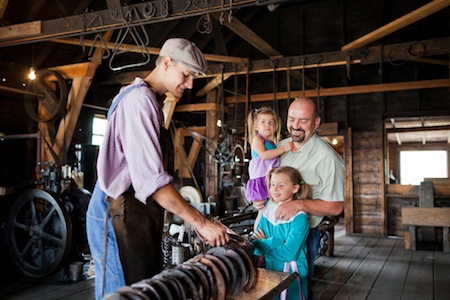
In the blacksmith forge at Heritage Park. Photo Courtesy Heritage Park
Dundurn Castle National Historic Site Hamilton, Ontario
In the basement of Dundurn Castle are the kitchens used to cook for Sir Allen MacNab and his family back in 1855? This National Historic Site gives us a look at life for the well to do in a grand mansion, with extensive grounds and authentic gardens. With most of the servants working in the lower level of the estate, we can get a taste of a Canadian version of “Downton Abbey”. Beginning in gardens of the extensive property, families can see, learn and help work in heritage food gardens that put the hearty meals on the table for the MacNabs each day. Cooking and gardening programs such as Plant, Bake, Hunt and Eat; MacNab’s Kitchen; Strawberry Soiree; Weeding Wednesdays in Dundurn Kitchen and different Christmas cooking classes. Children can take home memories of baking and eating Christmas cookies while tasting a bit of life in the time of the MacNabs.
Fort Langley National Historic Site, just a short drive from Vancouver, British Columbia is an old Hudson’s Bay Company Trading Post. Buildings are both original, and some have been reconstructed. The Kwantlen First Nations brought salmon to the fort to trade that was then salted and shipped to Hawaii, as well as cranberries. The newly renovated restaurant “lelem’ at the Fort Café” serves historically themed food options to help give visitors a taste of life at the trading post.
A little boy walked away from Fortress Louisbourg on the fog-covered path. On his head, he wore a French style soldier’s hat, and he had a wooden gun and a loaf of soldiers bread from the bakery tucked under his arm. He could still smell the hot chocolate being cooked in the Engineer’s kitchen and could taste the soup and homemade bread he had eaten for lunch. He had learned a lot about Canada’s history that day, without even knowing it, but mostly he would never forget that special day with his family.
By Jan Feduck
 Jan Feduck is a freelance writer from Elora, Ontario who spends her summers in Nova Scotia. She has travelled the world both with and without her husband and three children along. Now, adults, they have continued to love travel. She has done long and short term travel to over 44 countries, travelling by foot, bicycle, train, bus, freighter, plane, kayak and canoe. Among her highlights were an unguided trek to Mt. Everest in the 1970s, walking the Camino de Santiago in Spain, living and volunteering in Thailand for nine months and all the travel she has done with her family. She has a particular interest in places that teach us about food history and writes a blog called Dining Out with History.
Jan Feduck is a freelance writer from Elora, Ontario who spends her summers in Nova Scotia. She has travelled the world both with and without her husband and three children along. Now, adults, they have continued to love travel. She has done long and short term travel to over 44 countries, travelling by foot, bicycle, train, bus, freighter, plane, kayak and canoe. Among her highlights were an unguided trek to Mt. Everest in the 1970s, walking the Camino de Santiago in Spain, living and volunteering in Thailand for nine months and all the travel she has done with her family. She has a particular interest in places that teach us about food history and writes a blog called Dining Out with History.
Jan’s conviction is that To Travel is to Learn, and she loves to create trips that visit the unusual corners of our earth. The people she meets on the road are the most meaningful part of each journey.




